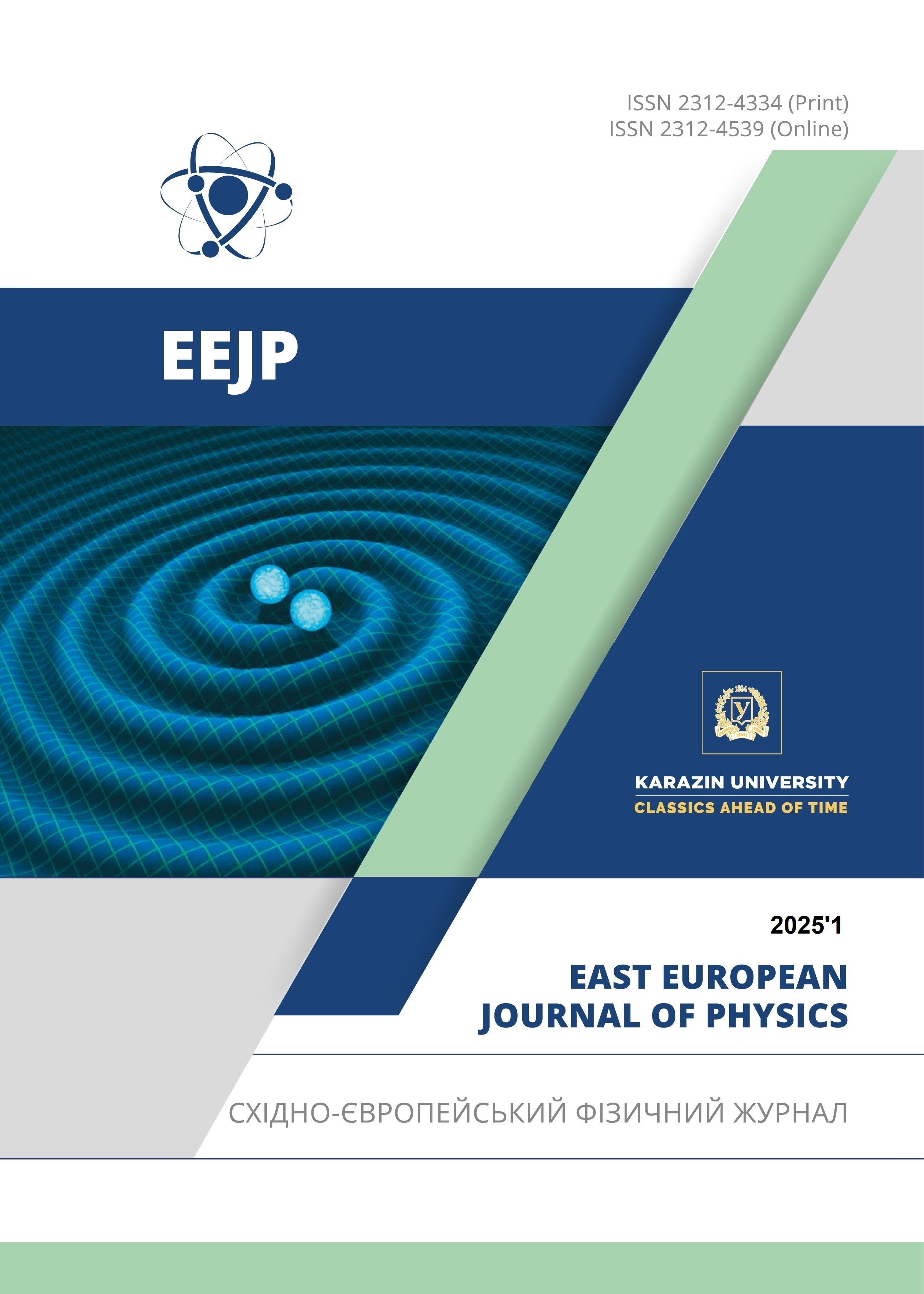Impact of Resistivity on Electrical Characteristics of Al-Doped ZnO/p Si Heterostructures
Abstract
This study investigates the impact of the resistivity of Aluminum-doped Zinc Oxide (AZO) films on the electrical characteristics of AZO/p-Si heterojunctions. AZO films were deposited using a thermal evaporation technique on p-Si substrates, with varying deposition temperatures to control film morphology and resistivity. Comprehensive current-voltage (I-V) and capacitance-voltage (C-V) measurements were conducted to evaluate the diode performance and interface state dynamics. The results show that samples with higher resistivity, particularly those deposited at room temperature (S1 and S2), exhibit MOS-like behavior, indicating higher concentrations of interface states and defects. In contrast, samples deposited at elevated temperatures (S3, S4, and S5) demonstrate improved diode characteristics, with lower resistivity, enhanced carrier mobility, and better crystalline quality. Mott-Schottky and capacitance-frequency (C-f) analyses further reveal the significant role of interface states in determining the heterojunction's electrical response, especially at lower frequencies where charge trapping dominates. Additionally, photoluminescence (PL) spectra confirm the presence of oxygen vacancies in the AZO films, with strong visible emission observed in S1 and S2, linked to deep-level defect states. This work highlights the critical influence of deposition conditions on the resistivity and performance of AZO films in heterojunction-based optoelectronic devices, offering valuable insights into optimizing material properties for improved device efficiency.
Downloads
References
R.A. Antwi, I. Nkrumah, F.K. Ampong, M. Paal, R.Y. Tamakloe, R.K. Nkum, and F. Boakye, “Synthesis of Pure and Manganese Doped Zinc Oxide Nanoparticles by a Solution Growth Technique: Structural and Optical Investigation,” East European Journal of Physics, (4), 129-136 (2023). https://doi.org/10.26565/2312-4334-2023-4-13
Z.X. Mirzajonov, K.A. Sulaymonov, T.I. Rakhmonov, F.T. Yusupov, D.SH. Khidirov, and J.S. Rakhimjonov, “Advancements in Zinc Oxide (ZnO) thin films for photonic and optoelectronic applications: a focus on doping and annealing processes,” E3S Web of Conferences, 549, 03013 (2024). https://doi.org/10.1051/e3sconf/202454903013
R. Pietruszka, R. Schifano, T.A. Krajewski, B.S. Witkowski, K. Kopalko, L. Wachnicki, and E. Zielony, “Improved efficiency of n-ZnO/p-Si based photovoltaic cells by band offset engineering,” Solar Energy Materials and Solar Cells, 147, 164-170 (2016). https://doi.org/10.1016/j.solmat.2015.12.018.
N. Sultanov, Z. Mirzajonov, and F. Yusupov, “Technology of production and photoelectric characteristics of AlB 10 heterojunctions based on silicon,” E3S Web of Conferences, 458, 01013 (2023). https://doi.org/10.1051/e3sconf/202345801013
N.A. Sultanov, Z.X. Mirzajonov, F.T. Yusupov, and T.I. Rakhmonov, “Nanocrystalline ZnO Films on Various Substrates: A Study on Their Structural, Optical, and Electrical Characteristics,” East European Journal of Physics, (2), 309-314 (2024). https://doi.org/10.26565/2312-4334-2024-2-35
K.H. Kong, R. Kek, T.Y. Tou, and S.S. Yap, “Effects of the resistivity of AZO film on the IV and CV characteristics of AZO/p-Si heterojunction,” Microelectronic Engineering, 213, 24-30 (2019). https://doi.org/10.1016/j.mee.2019.04.011
S. Erat, A. Braun, S. Çetinkaya, S. Yıldırımcan, A.E. Kasapoglu, E. Gür, E. Harputlu, K. Ocakoglu, “Solution-Processable Growth and Characterization of Dandelion-like ZnO:B Microflower Structures,” Crystals, 12(1), 11 (2021). https://doi.org/10.3390/cryst12010011
M. Sharmin, and A.H. Bhuiyan, “Modifications in structure, surface morphology, optical and electrical properties of ZnO thin films with low boron doping,” Journal of Materials Science: Materials in Electronics, 30(5), 4867-4879 (2019). https://doi.org/10.1007/S10854-019-00781-8
A. Roy, and M. Benhaliliba, “Investigation of ZnO/p-Si heterojunction solar cell: Showcasing experimental and simulation study,” Optik, 274, 170557 (2023). https://doi.org/10.1016/j.ijleo.2023.170557.
Mohammad-Reza Zamani-Meymian, Nima Naderi, Maryam Zareshahi, Improved n-ZnO nanorods/p-Si heterojunction solar cells with graphene incorporation, Ceramics International, 48(23), 34948-34956 (2022). https://doi.org/10.1016/j.ceramint.2022.08.084
F.T. Yusupov, T.I. Rakhmonov, M.F. Akhmadjonov, M.M. Madrahimov, and S.S. Abdullayev, “Enhancing ZnO/Si Heterojunction Solar Cells: A Combined Experimental And Simulation Approach,” East European Journal of Physics, (3), 425-434 (2024). https://doi.org/10.26565/2312-4334-2024-3-51
D. Das, and L. Karmakar, “Optimization of Si doping in ZnO thin films and fabrication of n-ZnO:Si/p-Si heterojunction solar cells,” Journal of Alloys and Compounds, 824, 153902 (2020). https://doi.org/10.1016/j.jallcom.2020.153902
S. Karakaya, “Effect of fluorine and boron co-doping on ZnO thin films: Structural, luminescence properties, and Hall effect measurements,” Journal of Materials Science: Materials in Electronics, 29, 1628-1638 (2018). https://doi.org/10.1007/s10854-017-8352-x
N.M. Nemma, and Z.S. Sadeq, “Eco-Friendly Green Synthesis and Photocatalyst Activity of Ag-ZnO Nanocomposite,” East European Journal of Physics, (3), 271-278 (2023). https://doi.org/10.26565/2312-4334-2023-3-24
M.A. Shafi, S. Bibi, M.M. Khan, H. Sikandar, F. Javed, H. Ullah, L. Khan, and B. Mari, “A Numerical Simulation for Efficiency Enhancement of CZTS Based Thin Film Solar Cell Using SCAPS-1D,” East European Journal of Physics, (2), 52-63 (2022). https://doi.org/10.26565/2312-4334-2022-2-06
I. Kanmaz, “Simulation of CdS/p-Si/p+-Si and ZnO/CdS/p-Si/p+-Si heterojunction solar cells,” Results in Optics, 10, 100353 (2023). https://doi.org/10.1016/j.rio.2023.100353
S. Maqsood, Z. Ali, K. Ali, M. Ishaq, M. Sajid, A. Farhan, A. Rahdar, and S. Pandey, “Assessment of different optimized anti-reflection coatings for ZnO/Si heterojunction solar cells,” Ceramics International, 49(23), 37118-37126 (2023). https://doi.org/10.1016/j.ceramint.2023.08.313
S. Maity, and P.P. Sahu, “Efficient Si-ZnO-ZnMgO heterojunction solar cell with alignment of grown hexagonal nanopillar,” Thin Solid Films, 674, 107-111 (2019). https://doi.org/10.1016/j.tsf.2019.02.007
Q. Yu, H. Zhao, and Y. Zhao, “The study of optical-electrical properties of ZnO(AZO)/Si heterojunction,” Current Applied Physics, 57, 111-118 (2024). https://doi.org/10.1016/j.cap.2023.11.008
Copyright (c) 2025 Fakhriddin T. Yusupov, Mekhriddin F. Akhmadjonov, Dadakhon Sh. Khidirov, Dilmuhammad Kh. Tolaboyev, Ikhtiyor M. Tursunov

This work is licensed under a Creative Commons Attribution 4.0 International License.
Authors who publish with this journal agree to the following terms:
- Authors retain copyright and grant the journal right of first publication with the work simultaneously licensed under a Creative Commons Attribution License that allows others to share the work with an acknowledgment of the work's authorship and initial publication in this journal.
- Authors are able to enter into separate, additional contractual arrangements for the non-exclusive distribution of the journal's published version of the work (e.g., post it to an institutional repository or publish it in a book), with an acknowledgment of its initial publication in this journal.
- Authors are permitted and encouraged to post their work online (e.g., in institutional repositories or on their website) prior to and during the submission process, as it can lead to productive exchanges, as well as earlier and greater citation of published work (See The Effect of Open Access).








